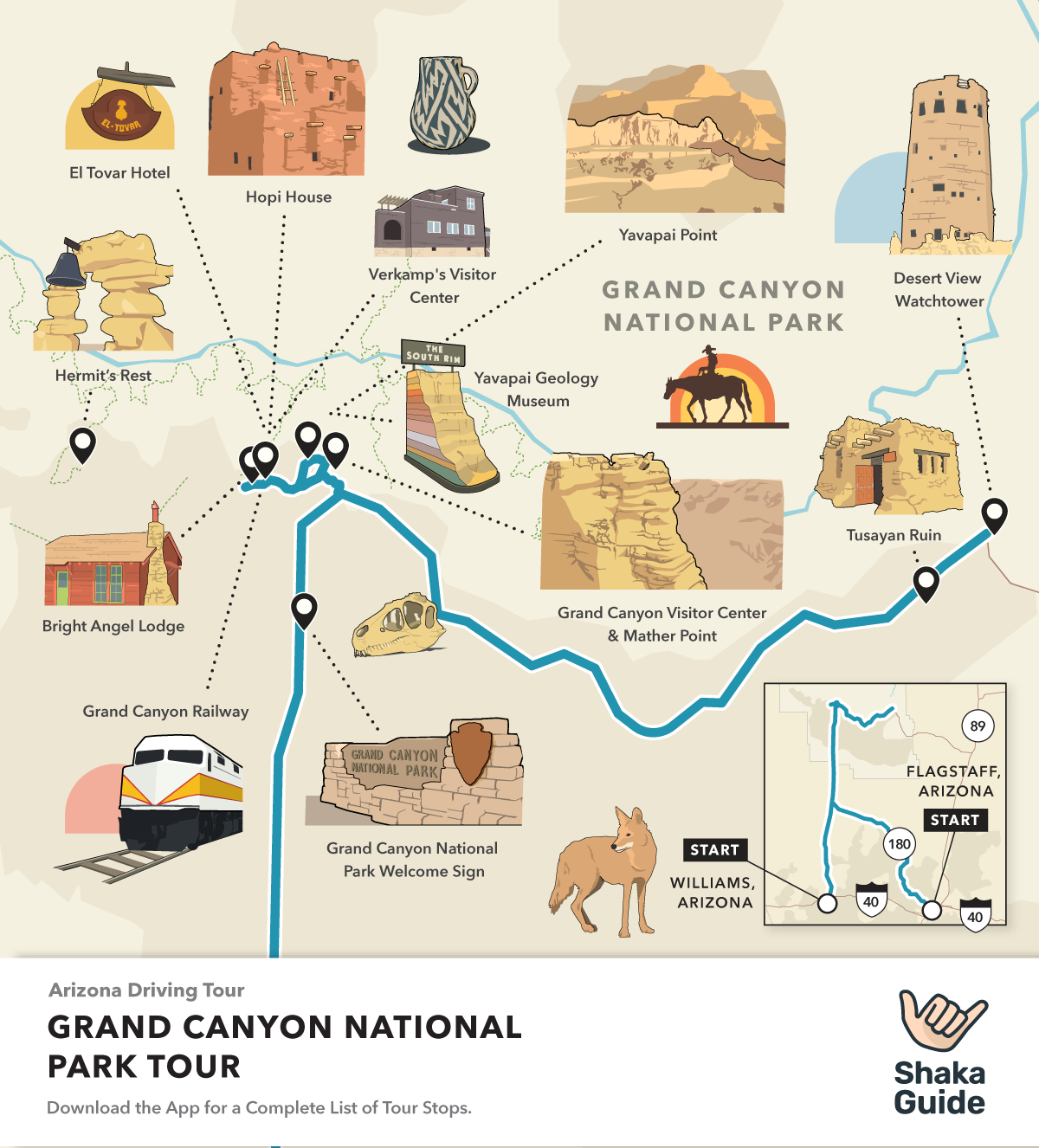
Why Winter is the Best Time to Visit the Grand Canyon

 Thinking of Visiting the Grand Canyon in Winter?
Thinking of Visiting the Grand Canyon in Winter?
Oh, the weather outside is frightful, but the Grand Canyon’s South Rim is delightful!
If you've never seen the Grand Canyon under a blanket of snow, you're in for a treat. Sure, summer may be the busiest season, but winter reveals a whole different side of this iconic place — quieter, calmer, and, honestly, kind of magical. Visiting the Grand Canyon South Rim in winter offers a unique perspective of one of the world’s most iconic natural wonders.
Snow dusts the towering cliffs in striking contrast with the rust-colored rock formations, and the crisp, cold air enhances the sense of adventure.
Of course, winter travel to the South Rim isn’t without its quirks...and a few limitations. Traveling to the South Rim in the colder months requires thoughtful planning to make the most of your visit.
Roads are less congested, and accommodations are easier to find during winter. However, icy trails and closures can present their own challenges.
With proper preparation, you can enjoy spectacular viewpoints, uncrowded trails, and the magic of sunrise and sunset over the canyon’s wintry expanse.
But with a little planning (and a warm jacket), this can be one of the most rewarding times to visit.
In this guide, we’ll walk you through everything you need to know — what to pack, how to stay safe, which viewpoints and trails are still open, and how to make the most of those golden winter sunrises and sunsets.
Let’s dive in — snow boots first.
Winter Weather
The Grand Canyon is located in Arizona, about seventy miles from Flagstaff, and about 270 miles from Las Vegas. And while it’s hard to believe—seeing as how it’s surrounded by desert— the Grand Canyon can get pretty cold in the winter months.
In fact, it regularly sees snow! Temperatures typically stay above freezing most of the year. However, between December and February, they average around 18 to 45°F. Which means it can get pretty cold when the sun goes down.
Reasons to Visit the Grand Canyon in Winter
Fewer Crowds
The South Rim of the Grand Canyon attracts up to five million visitors annually. Most of these visitors arrive during the summer months.
That means in the colder months, the viewpoints are less crowded, traffic is lighter, and parking is abundant.
In fact, winter at the Grand Canyon can feel like you’ve got the place all to yourself. Without the noise and distractions of large groups, the tranquility of the canyon becomes more pronounced, enhancing the awe-inspiring atmosphere.
RELATED ARTICLE: 20 Things to Do at the Grand Canyon South Rim
Viewpoints
There’s something pretty magical about seeing fresh snow covering the red and brown-hued rock formations that make up the Grand Canyon.
Mather Point and Yavapai Point, near the Visitor Center, offer iconic, accessible views of the snow-dusted cliffs. Hopi Point is renowned for its stunning winter sunsets, with golden light reflecting off the snowy canyon.
For panoramic vistas, Desert View and its historic Watchtower provide unparalleled views of the snow-capped landscape and the Colorado River. And Hermit’s Rest combines serene winter charm with awe-inspiring scenery.
The park offers two shuttles that run even when there’s snow on the ground—as long as there’s not a lot of snow on the ground.
Sunrise/Sunset
Winter sunrises and sunsets at the Grand Canyon are pure magic, especially when the snow adds a touch of sparkle.
For sunrise, Mather Point is a classic choice. It offers sweeping views as the first rays light up the canyon walls. Yaki Point is another hidden gem, with a quieter vibe and incredible eastward views.
For sunsets, Hopi Point steals the show, famous for its wide-angle perspective and vibrant colors reflecting on the cliffs.
Desert View is also stunning, with the Watchtower adding a historic touch to the glowing canyon. Bundle up—it’s worth every chilly moment!
Roadtrip!
Hermit Road is a scenic seven-mile drive along the South Rim that offers some of the park’s most stunning viewpoints. In the summertime, it’s only accessible by shuttle bus.
But in the winter, Hermit Road is open to private vehicles. This makes winter an ideal time to explore at your own pace.
The road features several breathtaking viewpoints, including:
- Hopi Point
- Mohave Point
- Pima Point
each offering a unique perspective of the canyon and dramatic photo opportunities.
At the end of the road is Hermit’s Rest, a cozy historic spot with a stone cabin, fireplace, and refreshments.
Holiday Activities
The Grand Canyon features holiday and winter-themed ranger programs. These offer insights into the park's history, wildlife, and cultural significance.
Be sure to stop in at the El Tovar Hotel along the rim, which features cozy decorations, holiday dining specials, and a warm, nostalgic ambiance perfect for the season.
Further south, in Williams, Arizona, the Grand Canyon Railroad turns into the Polar Express Train Ride and takes passengers on a magical journey to the Grand Canyon while providing hot cocoa, cookies, and visits from Santa.
If that’s not enough to entice you, the nearby towns of Williams and Tusayan, Arizona host craft fairs, markets, and festive events to celebrate the season.
Animals
The winter months are particularly good for spotting furry Canyon creatures! Why? Well, fewer crowds mean braver animals!
Keep your eyes peeled for majestic animals like elk and mule deer, often seen grazing in the meadows and near forested areas.
You may also see the tufted-eared Abet’s Squirrels, darting between ponderosa pines, and
intelligent ravens, soaring along the canyon's edges and scavenging near visitor areas.
What's open at the Grand Canyon in winter?
The Grand Canyon is open year-round, and, weather permitting, so are the roads and viewpoints.
There are three visitor centers along the south rim:
- the Main center
- Verkamps Visitor Center is next to the El Tovar Hotel
- Desert View Visitor Center, located on Desert View Road near the East entrance
These are all open during the winter months, too! And, there are two museums that stay open year-round—the Kolb Studio, which showcases art, photography, and canyon history in a historic building at the Bright Angel Trailhead.
And, the Yavapai Geology Museum, offers panoramic views and exhibits about the geology of the Grand Canyon.
For the avid hikers, most of the trails at the Grand Canyon are open, weather permitting. Check the Grand Canyon’s NPS page here for the most up-to-date information about road and trail closures.
RELATED ARTICLES: All About the Grand Canyon Shuttle Buses
Safety Tips for Grand Canyon Visitors
What to wear
Since temperatures can drastically change between day and evening hours, layering is key when visiting the Grand Canyon during the winter months.
Start with thermal or moisture-wicking long-sleeve shirts and leggings. Then, insulate with a fleece, down jacket, or wool sweater for extra warmth. It’s always a good idea to add a waterproof, wind-resistant jacket to protect against snow, rain, and wind.
Insulated, waterproof hiking boots with good traction are essential, as trails and roads can be icy or snowy. And, if you’re planning on hiking, don’t forget to pack microspikes or crampons for those boots.
And don’t forget sunglasses and sunscreen—sunlight reflecting off snow can be intense!
So, is the Grand Canyon worth it in winter?
Absolutely! Visiting the Grand Canyon in winter is a truly magical experience. With fewer crowds, you’ll have the opportunity to enjoy the park’s stunning vistas, peaceful trails, and historic landmarks in a tranquil setting.
By dressing appropriately, planning for variable weather, and using essential gear like traction devices for icy conditions, you can stay comfortable and safe while exploring.
Take advantage of unique winter perks, such as driving Hermit Road in your own vehicle, capturing the canyon’s snowy beauty in photographs, and spotting wildlife like elk and mule deer.
With careful preparation and a spirit of adventure, you can experience this natural wonder in a whole new light—peaceful, majestic, and uniquely yours to explore.
So pack your winter gear, plan your itinerary, and get ready for an extraordinary trip to the Grand Canyon during its quietest and most enchanting season!
Explore with Shaka Guide
Don’t forget to take Shaka Guide with you! We’ve hand-picked some of the best viewpoints, hikes, and activities to maximize your time and make your trip truly unforgettable.
Using GPS technology, the tour provides turn-by-turn directions and engaging stories that play automatically as you drive. And the tour will work splendidly even in the winter months!

Matt Caracciolo is a travel writer based in Ohio and author of the Shaka Guide tour for Yosemite. Born and raised in Columbus, Matt fell into travel writing while teaching English abroad in South Korea.
He has written two travel books, including the Moon Ohio guidebook, and enjoys writing and editing tours for Shaka Guide. Matt follows Mark Twain’s belief that “travel is fatal,” embracing travel as a way to learn more about the world and ourselves.
Ready to take the tour? Check out Shaka Guide's Grand Canyon South Rim National Park Tour!
We hope that we’ve given you all the information you need to make the most of your day. Your vacation is extremely important to us so if you have any questions feel free to reach out at aloha@shakaguide.com.
For more detailed information to help you plan, check out our Grand Canyon South Rim National Park Itinerary and Know Before You Go article.
Like this article? Share it on Pinterest!

RELATED ARTICLES:
The Ultimate Grand Canyon South Rim Travel Guide
Grand Canyon, North vs South Rim: Everything You Need to Know
The Best Views Grand Canyon South Rim
20 Things to Do at the Grand Canyon South Rim
Top 16 Grand Canyon South Rim Hikes
Hiking into the Grand Canyon South Rim
All About the Grand Canyon Shuttle Buses
How To Get From Las Vegas to Grand Canyon South Rim
Flagstaff to Grand Canyon North Rim: 8 Stops Along the Way
Zion to Grand Canyon North Rim - What You Need To Know





























 to fuel your ride
to fuel your ride 
